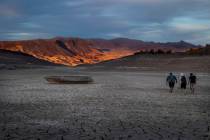Regulators’ signals mixed on how land designated
This land is your land. This land is my land. ... This land was made for you and me." As an elementary school student I enthusiastically sang those lyrics penned by Woody Guthrie in the 1940s. More importantly, I believed them and believed they had special reference to our public lands and wide-open spaces here in the West.
People need open spaces. Spend time reading literature on the recreational needs of human beings and you always will find open space designated as a need and not simply as a want. A formula exists for calculating how much open space we require.
But open space is more than a collection of ballfields and picnic benches and can be found only in wild America.
Unfortunately, some believe the only way you should enjoy the outdoors is under layers of regulation. While I understand some regulation is needed if we are to protect open spaces, not only for generations to come but also for ourselves, not every open space should be given wilderness status or managed as such. Nor does every open space qualify for that designation.
A few weeks back I wrote about the Bureau of Land Management's closure of virtually all unpaved roads on the outskirts of Las Vegas to what is defined as off-highway travel. Keep in mind this closure applies to everything that has wheels, from a wheelchair or baby stroller to a full-size pickup and beyond. It also applies to every existing unpaved road.
The real issue extends further than whether four-wheelers or motorcycles can or should be operated outside of town.
The issue is about the freedom to access the publicly owned open space that lies right outside of our collective back door.
The Wilderness Act of 1964 defines wilderness as "an area where the earth and its community of life are untrammeled by man, where man himself is a visitor who does not remain ... an area of undeveloped Federal land retaining its primeval character and influence, ... and which (1) generally appears to have been affected primarily by the forces of nature ... (2) has outstanding opportunities for solitude or a primitive and unconfined type of recreation ... (3) has at least 5,000 acres ... and (4) may also contain ecological, geological, or other features of scientific, educational, scenic, or historical value."
Though the area closed to off-highway travel is not designated as a wilderness area, a comparison of regulations will show that with few exceptions it is being managed as one. Does the area within the BLM off-highway vehicle closure meet the criteria for management as a wilderness? It hasn't met that criteria since before World War II. Do we need wilderness areas? Yes, but not on every piece of public land.
In the Southwest, open space is part of who we are, especially for those of us who grew up here. All around us are publicly owned lands where people once could hunt, hike, ride, drive or otherwise recreate without having to ask for permission. Access closures, under various management designations and agency jurisdictions now surround us on all sides. Combined with the off-highway vehicle closure, the amount of land we're talking about is the size of some Eastern states.
During my research for my initial column about the off-highway closure, I learned the closure was created through public notice in the February 1998 edition of the Federal Register. The closure was amended and the affected area enlarged just nine months later in November. Local managers were given a sundry list of reasons to issue a closure order without going through the normal public input process required under the Federal Land Policy and Management Act.
Ironically, during the same time frame, the BLM was hammering out details of the Las Vegas Resource Management Plan. This was a highly publicized process. Within the pages of that plan, dated May 1998 and available at the BLM office, much of the public land now included in the off-highway vehicle closure was designated for off-highway travel "limited to existing roads, trails and dry washes for all motorized and mechanized vehicles." It is an area that encompasses more than 2 million acres.
Travel limited to existing roads, trails and dry washes? That's a concept we can live with. So which document do we go by, the closure noticed in the widely read Federal Register or the Resource Management Plan touted before the public?
Doug Nielsen is an award-winning freelance writer and a conservation educator for the Nevada Department of Wildlife. He can be reached at doug@takinitoutside.com.
C. DOUGLAS NIELSENMORE
COLUMNS

















